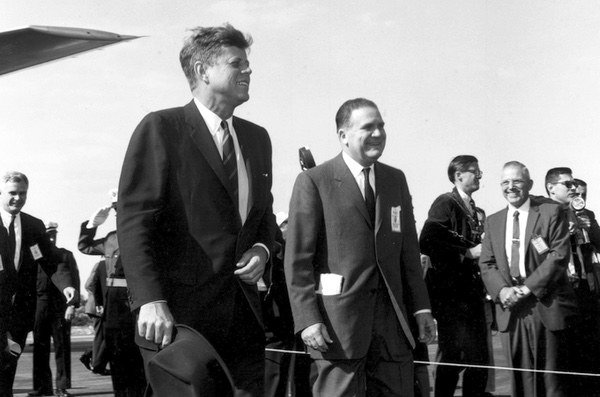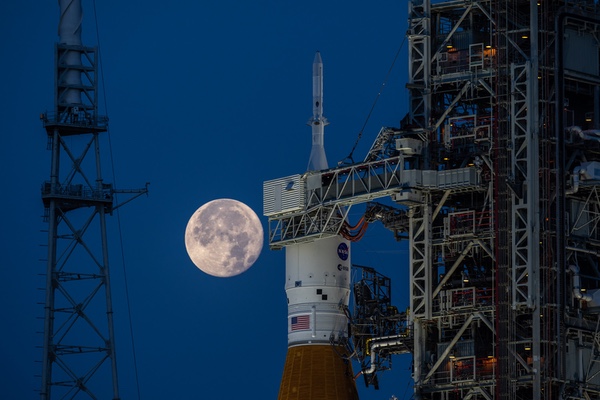https://www.nytimes.com/2022/07/31/obituaries/nichelle-nichols-dead.html
Since I was a young child Mars held a special fascination for me. It was so close and yet so faraway. I have never doubted that it once had advanced life and still has remnants of that life now. I am a dedicated member of the Mars Society,Norcal Mars Society National Space Society, Planetary Society, And the SETI Institute. I am a supporter of Explore Mars, Inc. I'm a great admirer of Elon Musk and SpaceX. I have a strong feeling that Space X will send a human to Mars first.
Sunday, July 31, 2022
Saturday, July 30, 2022
Friday, July 29, 2022
Wednesday, July 27, 2022
Will NASA Rename The James Webb Space Telescope?
Will NASA rename the James Webb Space Telescope?A space expert explains the Lavender Scare controversyby Alice Gorman |
| Webb’s exact role in the Lavender Scare is hotly debated. |
In the excitement, it’s easy to forget the Webb telescope has been the subject of controversy. It’s named after a NASA administrator who has been associated with the persecution of queer people in the “Lavender Scare” of the 1950s and ‘60s.
Who was James E. Webb?
James Edwin Webb was born in 1906 in North Carolina. He gained degrees in education and law, and spent time in the US Marine Corps.
He held a senior position in the State Department from 1949 until the early 1950s. In 1961, US President John F. Kennedy nominated Webb for the position of NASA administrator, the second since the agency was established in 1958.
In this role, he was responsible for the Apollo program to land humans on the Moon. He was very successful in lobbying for support from Congress, and also navigated NASA through the difficult aftermath of an incident in which three Apollo 1 astronauts lost their lives in a capsule fire on the ground.
Webb pushed for science to be prioritized in the Cold War environment, where every space mission was a political tool. He also promoted “psychological warfare” (or propaganda).
Webb left NASA in 1968, before Apollo 11 flew to the Moon. In later life, he served on various advisory boards and was involved with the Smithsonian Institution, the US flagship cluster of museums and education and research centers. He died in 1992.
What was the “Lavender Scare”?
During the Cold War, Western capitalist democracies feared communist infiltration. This became known as the “Red Scare”. The “Lavender Scare” was entwined with this paranoia.
| Is it any better if Webb was passively enacting the policies rather than leading the persecution? |
Proponents of these ideas argued that because of the social stigma attached to their sexuality, LGBTQ+ people were at risk of being blackmailed into becoming Soviet spies. From the late 1940s, under the influence of Republican politician Joseph McCarthy, LGBTQ+ people were purged from US government employment.
Webb’s exact role in the Lavender Scare is hotly debated. Several astronomers petitioning to have the telescope renamed have noted Webb (while at the State Department) was involved in high-level meetings about Lavender Scare policies.
In a Scientific American article last year, authors led by cosmologist Chanda Prescod-Weinstein wrote:
The records clearly show that Webb planned and participated in meetings during which he handed over homophobic material. There is no record of him choosing to stand up for the humanity of those being persecuted.
But according to a 2021 Nature article:
David Johnson, a historian at the University of South Florida in Tampa who wrote the 2004 book The Lavender Scare, says he knows of no evidence that Webb led or instigated persecution. Webb did attend a White House meeting on the threat allegedly posed by gay people, but the context of the meeting was to contain the hysteria that members of Congress were stirring up. ‘I don’t see him as having any sort of leadership role in the Lavender Scare,’ says Johnson.
Is it any better if Webb was passively enacting the policies rather than leading the persecution? Other government departments did actively oppose the investigation and sacking of LGBTQ+ employees.
Echoes of controversy
Space instruments are usually named via a consultation process, often with the public invited to contribute their ideas. It’s also not unusual for spacecraft names to be changed. For example, the 1991 Gamma Ray Observatory was renamed after physicist Arthur Holly Compton after its launch.
The Webb telescope’s name was chosen by NASA administrator Sean O’Keefe in 2002. NASA’s official response to the controversy is that there is “no evidence at this point that warrants changing the name of the telescope”.
Whatever Webb’s role in the Lavender Scare, the question for some observers seems to come down to whether he was personally homophobic. Framing the issue like this has echoes of another controversy: the complicity of German rocket scientist Wernher von Braun in the Third Reich.
| Science is meant to be objective and have no prejudice. In reality, scientists and science administrators are people like any others, with their own ideologies and flaws. |
Von Braun, who was a member of the Nazi Party and an SS officer, played a pivotal role in the US space program. Today, NASA mentions von Braun’s Nazi past on its website. But space historian Michael J. Neufeld says “his Nazi record was not widely known until after his death”. Many excuse von Braun’s political allegiance by arguing he just wanted to launch rockets into space.
Where to from here?
The James Webb Space Telescope is a touchstone for issues that have come to the fore in recent times.
For example, there has been a backlash against the memorialization of colonial “heroes” who perpetrated violence against Indigenous and enslaved people, leading to statues all over the world being toppled.
Some decry the idea of inclusivity as the ultimate in “wokeness”. Others argue maintaining historical barriers to participation in science—based on race, class, gender, and disability—means we lose potential talent. Science is meant to be objective and have no prejudice. In reality, scientists and science administrators are people like any others, with their own ideologies and flaws.
The question is whether we judge them by the standards of their time, or by those we hold today. In the end, perhaps we should remember that the Outer Space Treaty of 1967 proclaims that space belongs to all humanity.
This article is republished from The Conversation under a Creative Commons license. Read the original article.
Alice Gorman is an Associate Professor in Archaeology and Space Studies at Flinders University in Australia.
Note: we are using a new commenting system, which may require you to create a new account.
The Rebirth Of NASA
The rebirth of NASAby Roger Handberg |
| JWST represents a situation where the agency can take bows for performance in the end, although the end came much later than most thought in the beginning. |
Why these two programs signal change is found in programs’ trajectory. JWST has, after a lengthy developmental process, reached its desired location and received first light. The first images it produced open new vistas for exploration, expanding human understanding of the universe. One could argue that all will be forgiven as JWST moves into its role as the best view humans have of the cosmic past. In a sense, JWST will enjoy the prestige and stature of the Hubble Space Telescope, which had to survive the debacle of an improperly ground mirror: myopic given the expectations before launch. Fortunately, a repair flight in 1993 corrected the error. The rest, as they say, is history: a series of trailblazing images from across the universe, such as the Pillars of Creation in the Eagle Nebula.
JWST, to this point, has not encountered any equivalent trouble after launch, which is fortunate since it is located beyond the present capability of being reached for repair or simply refueling. What is occurring is another NASA opportunity to reach out beyond the usual suspects who support the space program and the agency. The holy grail of NASA is to recapture the public support it thought supported the agency through Apollo—a situation more complicated than simple adoration as much of the public was supportive in the abstract and more skeptical when asked to rank space as a priority against other national needs. Regardless, JWST represents a situation where the agency can take bows for performance in the end, although the end came much later than most thought in the beginning. The technical challenges were overcome, and the plan of operations was ultimately executed despite some hiccups in terms of schedule and cost. This ultimate success is contrasted with the continuing struggles of the SLS to gain traction and get to orbit.
SLS is on a slow torturous run up to its first test flight, hopefully followed by crewed missions both as test flights and future missions to the lunar surface. Like the space shuttle, SLS will be declared operational shortly after a few flights rather than a rigorous multiple flight program. The reason is the same in both cases: cost and time. SLS is extremely expensive (like JWST) and behind schedule, but the reality is that its cost means its usage will be limited to possibly two flights a year. Ironically, the Saturn V, which worked, was deemed too expensive, so the space shuttle was built. The shuttle proved too expensive and fragile, so it was cancelled in the hope that the Constellation program would produce a shuttle successor. Instead, the Ares I was cancelled and replaced by the SLS and, more importantly, the vehicles developed under NASA’s commercial cargo and crew programs.
| NASA wants control over its future but its fixation on operating launch systems is a road to irrelevance over the long haul. |
The arrival of the commercial vehicles was critical to getting the United States back to servicing the ISS without total dependence on Russia or other foreign partners. That same approach was applied to crew movement to the ISS and back through the Commercial Crew Program. Through SpaceX initially, and Boeing possibly soon, the United States now provides complete service to the ISS for NASA missions. This has become a central pillar in the establishment of what is termed a “low Earth orbit economy.” Commercial options are being relied on to develop future human landing systems for arriving on the lunar surface. What is occurring is a dramatic change in the composition of the American human spaceflight program: commercial options are appearing in the exploration matrix in increasing numbers and locations.
SLS clearly lags in terms of development, with the possibility of becoming irrelevant in terms of future US human space exploration. Several commercial firms, notably SpaceX and Blue Origin, are pursuing development of heavy-lift vehicles that could, in principle, replace the SLS as the workhorses for US human space exploration efforts. Unless the SLS becomes operational in a reasonable timeframe, it becomes a failed option, especially if the difficulties in development persist into the operational phase of its activities. The most recent public display of SLS performance was testing of the vehicle on the launch pad. A first set of tests in April was cut short while the second in June was incomplete, but the announcement was things are right on schedule.
Why this is important is that it reinforces the idea that NASA should stop being the one doing operational systems such as launch vehicles. That should be given to the commercial sector while the agency works on science and technology development. NASA started the move away from the operational end of spaceflight in the 1990s with the X-33 program, which was cancelled in 2001. That ultimately led the agency back into the thicket of being developer and operator of operational systems, a task that consumes resources, especially human resources that are scarce if you want top-flight talent to work for the agency. NASA wants control over its future but its fixation on operating launch systems is a road to irrelevance over the long haul. The commercial sector is replacing NASA in LEO as was expected and desired once the shuttle program terminated in 2011. The SLS became the last gasp of the old order (which grew out of the Apollo era with its comparatively larger budgets) and it is failing the test of relevance. Artemis I will likely fly but if other options become available, the vehicle may find itself in a cul-de-sac with no future. High cost and apparent fragility make the SLS ultimately unattractive for a robust exploration effort.
NASA is confronting a moment of truth in that science and technology development (both space and aerospace) will become its future, one which builds on the talents and expertise of its workforce. Human exploration can continue to be a core mission of the agency, but the technology for getting there will become more private sector than government program. Providing incentives for developing new transportation technologies for moving out into the solar system becomes the wave of the future. The US Space Force lurks on the sidelines for now, but it will become a partner for some of those missions, resurrecting the expeditionary model that explored the North American continent in the early days of the republic. For NASA, the choice may not be the agency’s but rather one imposed from outside, just like the agency was imposed on the US military in 1958 despite their expectations that space would be dominated and led by the military.
Roger Handberg is a professor of political science at the University of Central Florida.
Billionaires And Backlash-Suborbital Spaceflight One Year Later
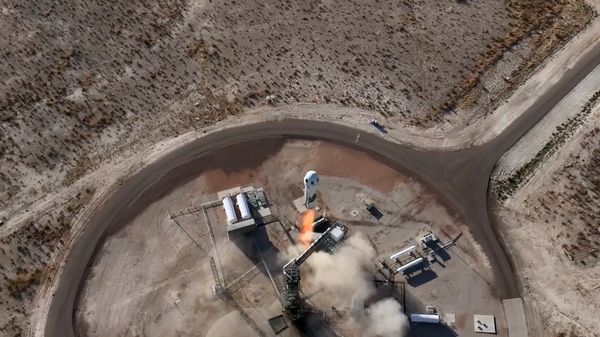 Blue Origin’s New Shepard lifts off on a June mission, just the fourth to carry people since company founder Jeff Bezos flew to space a year ago. (credit: Blue Origin) |
Billionaires and backlash: suborbital spaceflight a year after Branson and Bezos
by Jeff Foust
Monday, July 25, 2022
A year ago, the space community watched a marathon end with a sprint. After many years of development, and many years of delays, both Blue Origin and Virgin Galactic finally flew their founders to space days apart. Richard Branson went on Virgin Galactic’s SpaceShipTwo nine days before Jeff Bezos went on the first crewed flight of Blue Origin’s New Shepard. It marked the end the lengthy development phase of commercial human suborbital spaceflight and the promise of a new era of operational flights that would give many more people a chance to briefly experience expansive views and microgravity (see “Will suborbital space tourism take a suborbital trajectory?”, The Space Review, July 26, 2021).
That new era is slow to take off. A year after the dueling flights, Blue Origin has performed only a handful of flights as it eases into commercial service. That’s still better than Virgin Galactic, whose SpaceShipTwo has yet to fly since taking Branson to the edge of space last July as the company overhauls its fleet and plans for a new generation of vehicles. Even the promised—or feared—backlash against the “billionaire space race” has largely fizzled.
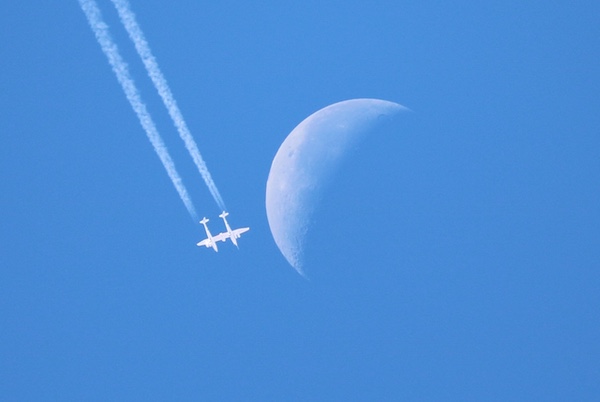 Virgin Galactic’s WhiteKnightTwo aircraft, VMS Eve, heads back to Mojave for maintenance work last fall. The company has not flown the plane with SpaceShipTwo since the July 2021 suborbital spaceflight with Branson on board. (credit: Virgin Galactic) |
Slow liftoff
After Blue Origin’s NS-16 mission that took Bezos, his brother Mark, Wally Funk, and Oliver Daemen on a ten-minute flight beyond the Kármán Line and back, Blue Origin said it would ease into regular crewed flights. Company officials said at the time they expected to conduct two more crewed flights before the end of the year, but their plans for 2022 remained uncertain. “What we do in the following year I’m not sure yet. We’ll figure that out, and what the cadence will eventually be,” Bezos said at an event just after the flight.
Those near-term predictions were accurate. Blue Origin flew two more crewed New Shepard flights (and one carrying only experiments) in the rest of 2021, including the first six-person flight.
| “The challenge for Blue at this point is that we’re actually supply-limited,” Blue Origin’s Smith said. “It’s incumbent on us to go build new vehicles, get them ready and safely go fly, and also safely get our launch cadence up.” |
Early this year, Bob Smith, CEO of Blue Origin, suggested the company would increase its flight rate this year, saying at an FAA commercial space transportation conference in February that the company would “easily double” the number of people it flies this year compared to last year, when it flew 14 people. That would include bringing into service an additional New Shepard vehicle and turning around vehicles between flights faster.
“The challenge for Blue at this point is that we’re actually supply-limited. No business ever wants to be supply-limited when there’s robust demand,” he said. “It’s incumbent on us to go build new vehicles, get them ready and safely go fly, and also safely get our launch cadence up.”
However, the company is, in fact, operating at a slower flight rate than last year. Nearly seven months into the year, Blue Origin has made just two crewed New Shepard flights, carrying 12 people. On Friday, Blue Origin announced the six-person crew for its next New Shepard mission, NS-22, but did not disclose a launch date for it.
The flights have attracted a diverse mix of participants. There are celebrities like actor William Shatner and Michael Strahan, the former football player and current TV show host, who were gifted flights on New Shepard by Blue Origin. (Another, comedian Pete Davidson, backed out of a flight in March for reasons neither he nor the company disclosed.) Space For Humanity, a nonprofit organization, purchased a seat that it awarded to Katya Echazarreta, who became the first Mexican-born woman to go to space on the most recent New Shepard flight, NS-21. It purchased a second seat that it gave to Sara Sabry, set to become the first Egyptian to go to space on NS-22.
There’s also been a curious intersection between spaceflight and crypto groups. An organization called the Crypto Space Agency purchased a seat on the NS-21 flight and, through what effectively was a raffle, gave it to Victor Correa Hespanha, a Brazilian engineer. The company sold non-fungible tokens (NFTs) that served as entries into the raffle, although one of the founders of the group, Joshua Skurla, acknowledged in an interview that they did not sell enough NFTs to cover the cost of the flight.
Another crypto group, MoonDAO, purchased two seats on future New Shepard launches. Its members—a DAO, or decentralized autonomous organization, is a community-led group whose members vote on key decisions—awarded one seat to Coby Cotton, a co-founder of the “Dude Perfect” YouTube Channel, who will go on NS-22.
Most, though, bought their flights themselves. They represent a mix of wealthy individuals, many of which have an interest in exploration or extreme activities. One, Evan Dick, liked the NS-19 flight in December so much he flew again on NS-21 in June.
That pace of flights, while slow, still puts Blue Origin far ahead of Virgin Galactic, which has yet to fly SpaceShipTwo since Branson’s flight last July.
Immediately after that flight, Virgin Galactic offered a schedule that anticipated being back in service by now. It expected then to perform one more SpaceShipTwo flight, a mission for the Italian Air Force announced in 2019, then go into a maintenance period lasting several months before resuming flights in early 2022.
| Virgin Galactic will be able to fly fewer than 200 people a year until the Delta-class vehicles enter service—less if some of the flights are devoted to research rather than private astronauts. |
Weeks later, though, that schedule changed. Even as it reopened ticket sales—at a price of $450,000, $200,000 higher than previously—it pushed back the start of commercial flights to late in the third quarter, citing the need to do more work on both the SpaceShipTwo vehicle named VSS Unity and the WhiteKnightTwo carrier plane, VMS Eve, to enable more flights.
By September, Virgin Galactic changed its plans again, moving immediately into that maintenance period and delaying the Italian Air Force flight. Its schedules have continued to slip, and as of the company’s latest earnings report in May, it now expects commercial service to begin in the first quarter of next year, blaming supply chain problems and a workforce spread over multiple projects for the latest delay.
If the company managed to stick to that schedule, VSS Unity will return to service in early 2023, flying once a month. It will be joined later next year by VSS Imagine, the first and likely only “SpaceShip III” vehicle, capable of flying twice a month.
Virgin Galactic, though, is betting its future on a new generation of vehicles. The “Delta-class” suborbital spaceplanes will be able to fly weekly and be manufactured at higher rates thanks to partnerships with other aerospace companies. Those vehicles, though, won’t be ready to start flying customers until 2026.
The company is taking steps to produce the Delta-class vehicles as well as new carrier aircraft. Virgin announced July 6 a contract with Aurora Flight Sciences, a subsidiary of Boeing, to produce components for two new aircraft that will be assembled at Virgin’s factory in Mojave, California. The Delta-class spaceplanes, meanwhile, will be assembled at a new factory the company announced July 15 will be located in Mesa, Arizona. Virgin has not announced what suppliers it plans to work with for components for those vehicles.
The Delta-class spaceplanes and new aircraft will be able to support as many as 400 flights a year, the company claims. Assuming six people per vehicle and a current ticket price of $450,000, that would result in more than $1 billion in annual revenue—if the company can actually achieve that flight rate and sell tickets at those prices.
However, for the at least 800 people who have tickets (a number based on what the company reported in its May earnings announcement), they will have to wait years to fly. With Unity capable of carrying four people once a month and Imagine six people twice a month, Virgin Galactic will be able to fly fewer than 200 people a year until the Delta-class vehicles enter service—less if some of the flights are devoted to research rather than private astronauts.
 Jeff Bezos (left) and his brother Mark celebrate after their New Shepard flight last year. Bezos and Branson faced criticism as billionaires taking joyrides, but the backlash has had little impact on the industry. (credit: Blue Origin) |
Feeble backlash
The flights of Branson and Bezos a year ago generated a lot of enthusiasm and excitement, but also criticism. There seemed, at times, to be a steady drumbeat of op-eds, social media posts, and other comments criticizing the billionaires for spending their money on space rather than addressing social issues, endangering the environment with the emissions of their spaceflights, and more.
That criticism went all the way to the United Nations. In a speech last September, UN Secretary-General António Guterres warned of a “malady of mistrust” in the world, citing as one example “billionaires joyriding to space while millions go hungry on Earth.”
| “Why should I put my life’s energy into an industry that is just about the glorification of three big billionaires out there, having a bit of a jolly?” asked Baduel. |
Other times, the calls came from inside the space industry’s house. “Everyone in society, every citizen in the world, should be having benefit from space, and not only a few billionaires that want to do circles around the planet,” said Jean-Marc Nasr, executive vice president and head of space systems at Airbus, during a company event a day after the Guterres speech. “I think it’s what we do at Airbus: space that matters.”
That seemed to leave some advocates of commercial spaceflight feeling, or at least sounding, embattled, defending the industry against what to them sounded like an onslaught of criticism.
An example of that was a panel discussion at last month’s Summit for Space Sustainability in London by the Secure World Foundation and UK Space Agency. The panel, titled “Billionaires, Buzz, and Benefit: How Do We Fix Space’s PR Problems?”, featured a journalist, public relations executives, a social media influencer, and a spaceport CEO to discuss the perceptions of space among the public.
They argued that the exploits of billionaires in the industry was warping public perceptions of it. “The industry’s mission is not clear because, when you look at the sentiment analysis, data from social listening tools, everything is around launches and billionaires, and people just don’t feel part of that mission,” argued Farzana Baduel, CEO of Curzon PR. “They think to themselves, ‘Why should I put my life’s energy into an industry that is just about the glorification of three big billionaires out there, having a bit of a jolly?’”
Camille Calibeo, the social media influencer on the panel who also works for space refueling startup Orbit Fab, recalled what she saw on social media after the Branson and Bezos flights. “Oh my gosh, it was awful on TikTok and Instagram and Twitter,” she recalled, recalling “fighting” among people within the space industry and also those outside it. “People outside were thinking, ‘Why on earth are we watching Branson and Bezos go to space?’”
But while the experience on social media might have been awful—a not-uncommon experience in general these days—it’s not clear if the backlash has had any real effect on the industry. While the UN Secretary General may have criticized suborbital space tourism, the UN has done nothing else to try to slow it down. And despite concerns raised by Baduel that young people didn’t feel a part of the “mission” of space, there’s little sign of it slowing down the hiring or retention of employees in the field, an issue she raised (she suggested later in the panel that the industry could help humanize itself with a space technology reality show along the lines of “Love Island,” a risqué British reality TV series.)
| “Just as normal Americans pay taxes when they buy airline tickets, billionaires who fly into space to produce nothing of scientific value should do the same, and then some,” Blumenauer said a year ago. |
Perhaps the strongest evidence against a true backlash against the space industry, or billionaires within it, is an obscure House bill. Immediately after last July’s New Shepard flight, Rep. Earl Blumenauer (D-OR), a member of the House Ways and Means Committee, announced his intent to introduce a bill he called the Securing Protections Against Carbon Emissions (SPACE) Tax Act. The bill would levy a tax on commercial human spaceflight, with exceptions for those conducting scientific research.
“Space exploration isn’t a tax-free holiday for the wealthy. Just as normal Americans pay taxes when they buy airline tickets, billionaires who fly into space to produce nothing of scientific value should do the same, and then some,” he said in a statement. The bill would tax suborbital spaceflights on a per-person basis, with a “significantly higher excise tax” for orbital flights.
There was just one problem: the SPACE Tax Act didn’t exist. A spokesperson for Blumenauer said at the time that the release was “a starting point for conversations we are having with experts” and that the bill would be released in the “coming weeks.”
Weeks turned into months with no sign of the SPACE Tax Act. Another spokesperson for Blumenauer said in December that the congressman was still working on the legislation “and will introduce it in the new year.”
Finally, in April he introduced the bill, HR 7547. It imposes a 10% tax on tickets for commercial human spaceflights as well as a $100,000 tax per suborbital launch or $2 million for other commercial human launches. It was immediately referred to the Ways and Means Committee—which has done nothing to advance it. At this point in the year, with more pressing matters in Congress, it seems unlikely the bill will go far before the end of the current Congress, requiring Blumenauer and any supporters—the bill has no cosponsors—to start over next year.
The lack of activity and apparent interest in the SPACE Tax Act suggests there is not much of a backlash against suborbital space tourism, at least one strong enough to influence public policy. Perhaps people don’t care that much about suborbital spaceflight given all the other issues to worry about today. Perhaps, more damningly for the industry, is that suborbital space tourism is just not that important.
Jeff Foust (jeff@thespacereview.com) is the editor and publisher of The Space Review, and a senior staff writer with SpaceNews. He also operates the Spacetoday.net web site. Views and opinions expressed in this article are those of the author alone.
Note: we are using a new commenting system, which may require you to create a new account.
Russia To Leave The International Space Station After 2024
New Frontiers
RUSSIA

Russia will withdraw from the International Space Station after 2024, a move that comes amid tensions between Moscow and Western nations over the war in Ukraine, Sky News reported.
Yuri Borisov, head of the state-controlled space corporation Roscosmos, confirmed Russia’s departure Tuesday, adding that Moscow is now focusing on building its own orbital outpost.
Russian officials have been contemplating leaving the ISS since 2021 over concerns regarding the station’s aging equipment and safety risks, according to the Washington Post.
But the exit comes amid an ongoing spat over sanctions against Russia following its invasion of Ukraine earlier this year. In April, Borisov’s predecessor, Dmitry Rogozin, announced that Russia would halt cooperation on the ISS in response to Western sanctions, saying they were aimed at bringing “our country to its knees.”
Despite heightened tensions, NASA and Roscosmos reached an agreement earlier this month to ensure that the ISS always has at least one American and one Russian on board to keep the station running smoothly.
Both parties also agreed to allow astronauts to continue using Russian rockets and for cosmonauts to use SpaceX starting in the fall to travel to the aging orbital station.
Meanwhile, NASA officials unveiled plans earlier this year to decommission the ISS in 2031. It said the laboratory would continue operating until 2030 but its long-term future is unsustainable.
Tuesday, July 26, 2022
Monday, July 25, 2022
A Signal Far Away
A Signal Far, Far Away
For more than a decade, astronomers have been detecting strange and quick radio waves coming from space billions of light-years away.
Known as “fast radio bursts,” these intense, rapid signals emerge from unknown regions of the universe and last about a millisecond.
Since 2007, scientists have discovered hundreds of them but recently they came across the longest FBR ever found, USA Today reported.
In their study, a research team wrote that the new signal is the longest-lasting one to date – around three seconds, which makes it about 1,000 times greater than the average FBR.
But the new FBR also had a unique pattern: The team found that the radio wave bursts repeated every 0.2 seconds, a pattern resembling a “heartbeat.”
They added that the origins of the FBR – named FRB 20191221A – remain murky and it’s unclear which galaxy generated the space signal. But they suggested that the emissions are similar to a radio pulsar or a magnetar, two types of neutron stars.
Neutron stars emerge when big stars die and their cores collapse.
Scientists first found FRB 20191221A in 2019 via a radio telescope called Canadian Hydrogen Intensity Mapping Experiment. They hope that building more telescopes could facilitate the finding of more FBRs.
Co-author Daniele Michilli said that detecting FBRs provides information about their possible origins “and it gives us a new tool that, maybe in the future, we’ll be able to (use for discovering) new information about the universe.”
Sunday, July 24, 2022
Saturday, July 23, 2022
Friday, July 22, 2022
Wednesday, July 20, 2022
Tuesday, July 19, 2022
ASATS And Space Law-Quo Vadis?
ASATs and space law: quo vadis?
by Leia-Maria Lupu and Maira Sophie Müller
Monday, July 18, 2022
On June 17, 2022, the International Space Station had to maneuver to avoid an imminent collision with space debris caused by an ASAT mission conducted by Russia in 2021. This calls attention to the overall safety of ASAT missions in light of the growing risk of space debris.
Antisatellite (ASAT) weapons are space weapons created to destroy other satellites such as through a shoot-down mechanism, with the explosion of the targeted satellite producing tons of space debris ranging from one millimeter to ten centimeters in size. Currently, there are two types of ASATs: co-orbital and direct-ascent. While the former is a weapon sent into orbit to destroy a target satellite in close proximity, the latter is a missile launched from the surface of the Earth targeting a satellite in orbit.
| Not communicating with the State parties, as well as acting with lack of due regard, represents a violation of a due diligence duty attached to conduct of space activities. |
The historic basis for these exercises was firmly tied to the Space Race during the Cold War. In an effort to prove technological superiority, the US and the USSR conducted projects, taking into account ballistic and defensive capabilities of outer space. Hence, the USSR launched its first ASAT in 1968. Following this, 15 other ASAT exercises were launched by India, the US, China, and Russia. Three exercises are most often referred to by the international space community: the 2007 Chinese ASAT, the 2008 American ASAT and the 2021 Russian ASAT.
Following the 2021 Russian ASAT, the ISS was subjected to severe risks. In the immediate aftermath of the exercise, the cosmonauts on the ISS had to shelter in their capsules because of the threat of space debris from the Soviet Kosmos-1408 satellite hitting the station, and on June 17, another maneuver was needed to avoid a dangerous collision of Kosmos-1408 debris with the ISS. The harmful potential of such missions is by no means minimal and consideration of seeking reparations for such damage becomes relevant.
On this premise, Article IX of the Outer Space Treaty (OST) recognizes a requirement on spacefaring nations to treat the interests of other States with due regard and communicate with thereof in the event of any potential damage concern. Thus, not communicating with the State parties, as well as acting with lack of due regard, represents a violation of a due diligence duty attached to conduct of space activities. Additionally, the provisions of the 1972 Convention on International Liability for Damage Caused by Space Objects (SLC) are squarely applicable. According to Article III of the SLC: “damage being caused elsewhere than on the surface of the earth to a space object of one launching State (…) the latter shall be liable only if the damage is due to its fault”. This provision gives us the lex specialis for liability, arising from the faulty conduct of a space mission damaging another space object. With the fulfilment of the fault requirement, injured States can use this rule to directly claim redress for the damage caused by an ASAT-launching State.
Ban of ASATs
Following recent developments of ASAT weapons, a general ban on testing direct-ascent of ASATs was advanced by the US, formally endorsed by Canada and supported by several other nations, such as Germany, France, Australia, and South Korea. Kamala Harris, in her April 18 address at Vandenberg Space Force Base in California, made clear the US commitment of not conducting “destructive, direct-ascent anti-satellite missile testing,” while also urging other nations to follow this initiative, outlining that “the US seeks so to establish a new international norm for responsible behavior in space.”
The question that arises now is how far this general condemnation of ASATs could constitute sufficient opinio juris to assert that such exercises are unlawful. This position is not new in international law. In 2010, the UN Committee on the Peaceful Uses of Outer Space (COPUOS) published its Space Debris Mitigation Guidelines deploring the creation of space debris and its harmful effects. In Guideline 4, the Committee stresses: “the intentional destruction of any on-orbit spacecraft (…) or other harmful activities that generate long-lived debris should be avoided.”
| It does not seem as if the states consider the use of ASATs as a breach of Article IX of the OST. |
Later in 2014, the UN General Assembly (UNGA) passed the “Prevention of an arms race in outer space” resolution calling upon states to act in alignment with the interest of the peaceful use of outer space and refrain from conducting any activities contrary to this purpose. Hence, there is a consistent body of opinio juris of states acquiescing to the severe risks that conducting ASATs poses, as well as to a general condemnation of deploying weapons in the volatile conditions of Outer Space.
Consequences of damages from a space object on Earth
In the case of an ASAT crashing on earth, Article II of the SLC stipulates that a launching state is absolutely liable for the damages caused on Earth, meaning that any fault on the side of the ASAT-launching state is rendered irrelevant. As such, the ASAT-launching state would be liable to pay compensation for the damage.
Now let us picture a situation where an ASAT generates space debris, which then, in turn, damages another satellite in space, later crashing on Earth and causing damage. Such an incident has never been reported, but given the risk that ASATs pose, it is not an unlikely situation to occur. It was also the case in this year’s Benjamin M. Telders Moot Court Competition for Public International Law. In that scenario, the launching state of the satellite would be absolutely liable to provide compensation under the SLC regime.
Nonetheless, the SLC offers an exoneration from absolute liability when the claimant state has acted with gross negligence or intent (Art. VI (1) SLC). In the possible event that the ASAT-launching state brings a claim against the launching state of the satellite because the latter caused damage to the former, it is reasonable to assume that the exercise of an ASAT mission counts as reckless behavior and a serious breach of due diligence to constitute gross negligence, keeping in mind that Article IX of the OST provides for a due diligence duty for states. However, in the aftermath of previous ASAT missions, space agencies and states avoided acknowledging them as a breach of Article IX, but instead, called for new rules regarding the use of ASATs in space. Therefore, it does not seem as if the states consider the use of ASATs as a breach of Article IX of the OST. Other guidelines that frown upon the creation of new space debris, which is inevitable in the case of ASATs, are not legally binding. Thus, it is a question whether it is indeed in accordance with state consent that such guidelines should be used as another due diligence obligation. Hence, it is not clear if States would consider the use of an ASAT as a ground for exoneration from absolute liability.
Contribution under ARSIWA
A state could also claim reparation under the Articles on the Responsibility of States for Internationally Wrongful Acts (ARSIWA) and the customary law enshrined in it. Particularly in the cases of damage that are not covered by the SLC, the lex generalis can be considered. Furthermore, Article VI of the OST imposes international responsibility on states for space activities, linking it to ARSIWA.
| There is no express rule of international law prohibiting the use of ASATs. As such, a broad loophole for States to continue endangering all spacecraft by conducting these exercises remains open. |
However, ARSIWA does not offer the possibility of an exoneration, but instead considers the contribution to injury by the injured state (Art. 39). Therefore, this would again only be relevant in cases where the space object damaged by the ASAT caused damage on the territory of the launching state of the ASAT. This provision also entails negligence. The considerations regarding gross negligence in Article VI of the SLC are therefore comparable, although the threshold is lowered for the contribution to the injury, as under Article 39 of ARSIWA, there is merely a requirement for normal negligence. As a result, it seems that it would be easier to consider the use of ASATs under the ARSIWA regime to the disadvantage of the ASAT-launching state.
Conclusion
The issue at hand is that there is no express rule of international law prohibiting the use of ASATs. As such, a broad loophole for States to continue endangering all spacecraft by conducting these exercises remains open. This leaves the international community with two options. First, new international rules could be introduced by drafting a new treaty regulating safe use of ASATs, or by refining the existing norms. Second, a customary rule could be established with the already sufficient opinio juris confirming States’ position on the matter, and, if enough States uniformly consolidate their commitment to ban ASATs, state practice could be provided for by means of such collective initiative.
Finally, we can only hope that the future development of international law will shine a light on how exactly ASATs can be employed bearing in mind the imminent resultant creation of space debris. It can be achieved by a multilateral ban or a stricter legal regime, and through a new strategy on how space debris can be safely and successfully mitigated.
Leia-Maria Lupu and Maira Sophie Müller are law students at Alexandru Ioan Cuza University in Iași, Romania, and Friedrich-Schiller-University in Jena, Germany, respectively.
Note: we are using a new commenting system, which may require you to create a new account.
Review-Apollo 11 Launch Plan
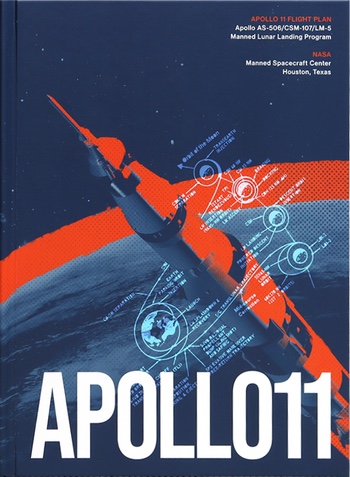 |
Review: Apollo 11 Flight Plan: Relaunched
by Jeff Foust
Monday, July 18, 2022
Apollo 11 Flight Plan: Relaunched
relaunch.space, 2022
hardcover, 400 pp., illus.
ISBN 978-1-6678-4082-6
US$59.00
This week marks the 53rd anniversary of the Apollo 11 landing. It is a milestone that is not particularly round (it’s prime, in fact) so it will not get much fanfare beyond some events linked with a new International Moon Day on and around July 20. It comes at the tail end of the celebrations of the overall 50th anniversary of the Apollo program, with that anniversary of the final Moon landing mission, Apollo 17, coming up in December.
| The illustrations are clear and the typography crisp, as if it has just come from the printer at the Manned Spacecraft Center in 1969. |
There is no shortage of historical accounts of Apollo 11, or of memorabilia. At the intersection of the two is Apollo 11 Flight Plan: Relaunched, a new printing of the flight plan used for the mission. It’s not the first republication of the plan, but the publisher, relaunch.space, argues it is the most faithful to the original.
The attention to detail is clear in this version of the book. The illustrations are clear and the typography crisp, as if it has just come from the printer at the Manned Spacecraft Center in 1969 (although those original copies were unlikely to be printed on glossy paper, like this version.) The publishers made this as authentic as possible, including adding at the front the “Revision A” distributed eight days before launch with last-minute corrections.
If there is a drawback to the flight plan, is that it’s just that: the flight plan from the mission. The publisher doesn’t include in the book any explanatory information about the contents of the flight plan, or why it was formatted in that way. The relaunch.space website does offer some details about how they produced the book, including redrawing illustrations and redoing typesetting.
This makes Apollo 11 Flight Plan: Relaunched a book primarily for spaceflight and space history enthusiasts and others already familiar with Apollo 11, people who want something as close as possible to an authentic record short of getting an actual copy printed for the mission. The book also serves as a reminder of the level of effort and detail required to send humans to the Moon and back. With a shift to electronic documentation, a replica like this may not be possible when it comes time to mark the 50th anniversary of Artemis 3—at least, not a printed replica.
Jeff Foust (jeff@thespacereview.com) is the editor and publisher of The Space Review, and a senior staff writer with SpaceNews. He also operates the Spacetoday.net web site. Views and opinions expressed in this article are those of the author alone.
Note: we are using a new commenting system, which may require you to create a new account.
The Transformation Of The James Webb Telescope
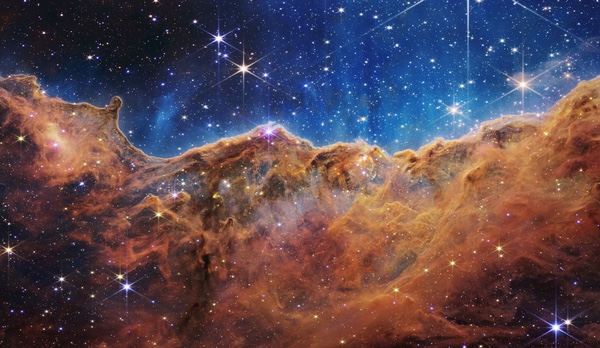 An image of the Carina Nebula taken by the James Webb Space Telescope, part of the early release observations published last week. (credit: NASA, ESA, CSA, and STScI) |
The transformation of JWST
by Jeff Foust
Monday, July 18, 2022
For all the anticipation about the first images from the James Webb Space Telescope, and the expectation that those images would be both aesthetically and scientifically stunning, the last thing you think you would need to get people hyped about the release of those images is a pep rally.
| “I didn’t know I was going to be at a pep rally,” Nelson said. “It’s all the better. You’ve got a lot to be rallying for.” |
Yet the atmosphere inside an auditorium last Tuesday at NASA’s Goddard Space Flight Center resembled that of a high school field house ahead of a big Friday night football game. A standing room audience, ranging from NASA leadership and members of Congress to scientists and engineers that worked on JWST, packed the room, while an emcee worked the crowd. “Let’s get excited!” she said, and the crowd cheered loudly.
Not loudly enough. “You can do a little better than that. Let me hear you again!” she implored. The crowd cheered about as loud as it did before. Good enough, apparently.
Then there were the ersatz cheerleaders, wielding gold pom-poms and gold cardboard hexagons, resembling the mirror segments of the space telescope. They first lined the stairwell leading up to the auditorium, yelling so loudly at times that some inside the room wondered if something either fantastic or disastrous had happened. They later took the stage.
“Gimme a J!” they shouted, and the audience complied. “Gimme a W! Gimme an S! Gimme a T! What’s that spell?” Um, JWST?
The atmosphere even took some NASA officials by surprise. “I didn’t know I was going to be at a pep rally,” NASA administrator Bill Nelson said when he took the stage. “It’s all the better. You’ve got a lot to be rallying for.”
“When I came up the stairs, by the time I got to the top, I wanted to throw off my jacket and run out to the 50-yard line,” quipped Greg Robinson, the program director for JWST at NASA headquarters who, decades earlier, played college football. “I don’t know what I would have done when I got there.”
That trying-too-hard overenthusiasm extended to the actual image release event, which took place not in that Goddard auditorium but in studios at the center and other locations in Europe and Canada. The unveiling of the four images and one spectrum was spread out over one hour, with lots of filler in the form of background information, interviews, and so on. But the event was riddled with technical glitches as the producers tried to jump from one studio to the next or bring up feeds of watch parties from Italy to India. When the show tried to turn to Canadian Space Agency headquarters to unveil an exoplanet spectrum, a buffering YouTube stream appeared on the screen, to groans and nervous laughter from the audience in the Goddard auditorium.
All could be forgiven, if not completely forgotten, by the time the images finally appeared. The images of the Carina Nebula, Southern Ring Nebula, a cluster of galaxies known as Stephan’s Quintet, and a deep field around the galaxy cluster SMACS 0723, and a spectrum of the exoplanet WASP-96 b, were hailed by professional astronomers and the general public alike.
“For me, the first thing that stood out about that image,” Amber Straughn, JWST deputy project scientist for communications at NASA Goddard, said of the deep field image, “was just the astounding detail that you can see in some of these galaxies. You can see star-forming regions in what are almost certainly very distant galaxies. They just pop out.”
| “We’re making discoveries and we’ve really haven’t started trying yet. The promise of this telescope is amazing,” said Smith. |
Even scientists who have been involved with JWST for decades were surprised. “I’ve been working on this project for 20 years, so we should expect what we saw,” said René Doyon of the University of Montreal, principal investigator for JWST’s Near-Infrared Imager and Slitless Spectrograph instrument. “But no. Several times in the last six months I nearly broke my jaw from what I saw, these incredible images.”
“I think our fellow scientists will feel the same thing when they look at the data,” he added. “These data are just amazing.”
That enthusiasm spread to the White House as well. That deep field image was unveiled the day before at an event attended by President Joe Biden and Vice President Kamala Harris. The oddly staged event—the president, vice president, and others sitting at desks, with a giant screen in the background—started more than an hour later, and the public portion ended after only about ten minutes, with only brief comments from Biden, Harris, and Nelson.
However, the briefing continued behind closed doors. “It was really fun. Oh my gosh,” recalled Jane Rigby, JWST operations project scientist at Goddard, who was there to explain the images. “They really geeked out. We had a closed-door session where we walked through all the images and just shared the excitement. They were so thrilled.”
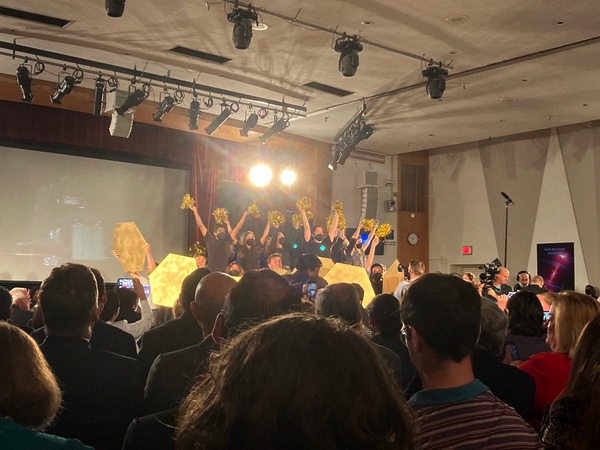 The celebration of the first JWST images at the Goddard Space Flight Center resembled a pep rally, including cheerleaders. (credit: J. Foust) |
“The promise of this telescope is amazing”
The purpose of JWST is not to produce images that excite the president and the public, but to perform cutting-edge science. The early release observations released last week offered a little bit of science: the spectrum of WASP-96 b, for example, revealed the presence of water vapor in that “hot Jupiter” exoplanet that orbits close to its star, while the deep field image revealed a galaxy more than 13 billion years old, and thus dating back to less than a billion years after the Big Bang.
The observations, though, were more about demonstrating the scientific potential of JWST. “They were more or less practice runs with the instruments,” said Eric Smith, JWST program scientist at NASA headquarters, at a briefing after the main event. “We’re making discoveries and we’ve really haven’t started trying yet. The promise of this telescope is amazing.”
Rigby recalled getting emotional when she saw some of the commissioning data, including “razor sharp” images better than expected. “Oh my goodness, it works, and it works better than we thought,” she said. “Personally, I went and had an ugly cry, because what the engineers have done to build this thing, it is amazing.”
It may take some time to truly push the limits of JWST, scientists suggested. The telescope is now starting a program of observations called Cycle 1 based on proposals submitted by scientists long before the telescope launched, and thus based on estimates and predictions. “Everything we planned for Cycle 1 in the astronomical community was bold, but it wasn’t bold enough,” Smith said.
He later explained at the briefing that astronomers submitting their Cycle 1 proposals were likely conservative in the number of objects they could observe or exposure times. “Now, what they’ll see when they can have access to these data is that they can expose shorter in some cases. They can have more targets, or they can go deeper than they thought. By Cycle 2—the next round of observations, proposals for which will be requested later this year—he said he expected astronomers “will be much more adventurous because they now know just how good the facility is.”
Even then, it will take years to analyze data and make the breakthrough discoveries, from the solar system to the early universe, long promised by the telescope. “We’ve designed this telescope and instrument to do incredible science that we’re going to start executing now, but we really don’t know what we’re going to find,” said Doyon.
He cited the example of the Hubble Space Telescope, launched with a major science goal of measuring the Hubble Constant, a measure of the rate of the expansion of the universe, only to discover that the expansion of the universe is accelerating. “Who knows what’s coming for JWST, but I’m sure we’re going to have a lot of suprises.”
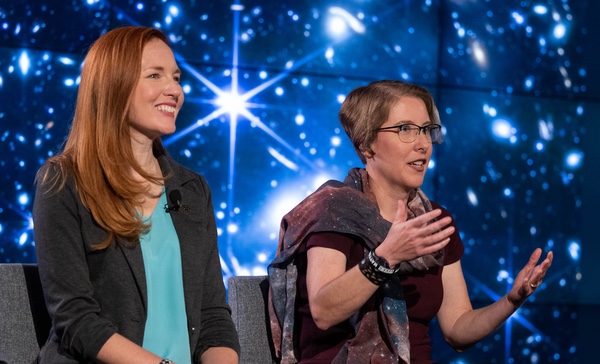 Astronomers Amber Straughn (left) and Jane Rigby discuss the early release observations at a July 12 briefing. (credit: NASA/Bill Ingalls) |
Beating spec
The reason scientists could be so exuberant and so hopeful about JWST is because the telescope worked better than expected. At the time of its launch last December, NASA warned of hundreds of potential single-point failures during the deployment and commissioning of the telescope and its instruments, failures that could impair or imperil the mission.
| “We knew how significant this observatory is. It’s the biggest, most complex science mission, potentially, that NASA has ever built,” Feninberg said. |
Yet the telescope made it through the six-month commissioning process with flying colors. “I was interviewed on ‘60 Minutes’ and when I got asked about confidence, I said I was 100% confident,” recalled Bill Ochs, JWST project manager at Goddard, during a briefing in June at the Space Telescope Science Institute. “Now, if you would have asked me if it would have gone 100% smoothly, that’s a different question. I would have said no, we would have had some issues in there.”
“It’s been an amazing six months,” he added. “Yeah, there were nerve-wracking times but, when you have confidence in your team, then you know you can get through those very nervous times.”
That confidence, in both building JWST and then commissioning it, led to a telescope that exceeded expectations. Lee Feinberg, JWST optical telescope element manager at Goddard, that the telescope had a requirement that its resolution be diffraction limited—that is, its sharpness limited only by the laws of physics—at wavelengths as short as 2 microns. He said the telescope was in fact diffraction limited down to 1.1 microns.
That performance extended throughout the telescope and instruments. “Across the board we beat spec,” Rigby said.
What’s the secret for that success? Feinberg credited that performance to several factors, such as attention to detail during its development, as well as extensive testing. “We knew how significant this observatory is. It’s the biggest, most complex science mission, potentially, that NASA has ever built,” he said.
“As the systems engineer, I made sure that we had margin, performance margin, that we can count on,” said Mike Menzel, JWST lead mission systems engineer at Goddard.
What makes it all the more remarkable is that the development of suffered a litany of technical problems that contributed to its lengthy delays. “The kinds of problems that we ran into during the development effort were things that had to be fixed,” said Charlie Atkinson, chief engineer for JWST at prime contractor Northrop Grumman, in an interview. “It wasn’t, ‘oh, that’ll degrade performance a little bit.’ It was, ‘we’ve got to fix this.’”
He said he was not surprised that, given all that effort, JWST was beating expectations. For example, the requirement that the telescope be diffraction limited at 2 microns carried with it a 95% confidence level. “That means you’re most probably going to be diffraction limited better than that, and what’s indeed what we’re seeing,” he said. “It’s as should be expected, but still, it’s heartwarming to see that it’s coming to that.”
The biggest issue is one that engineers have little control over: the micrometeoroid environment at the Earth-Sun L-2 point. A few micrometeoroids have hit the telescope’s mirrors since its launch: about one per month, within expectations, said Menzel in June. However, the most recent one, in May, was larger than had been modeled and caused damage to the mirror that could not be fully corrected by adjusting the mirror.
However, despite some sensational headlines about “permanent damage” to the telescope that is “uncorrectable,” those involved with the mission are not concerned. “Time will tell whether that last impact was just an anomaly,” Menzel said. “One way or another, the telescope, even after that last impact, is working magnificently, about two times better than we thought.”
He said there are steps the mission can take to reduce the risk of future micrometeoroid damage to JWST’s mirrors. That includes, he said, maneuvering the telescope so the mirror does not face tails of debris associated with meteor showers.
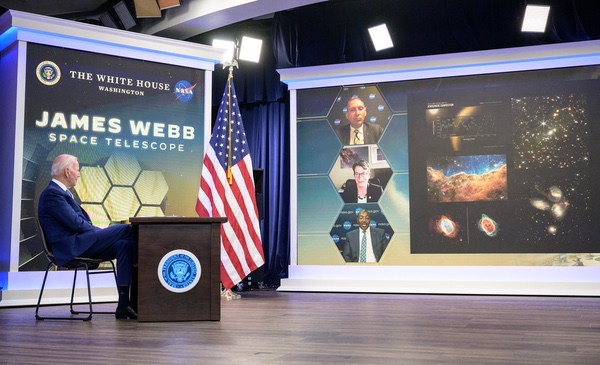 President Biden at a White House event July 11 to preview the first JWST images. (credit: NASA/Bill Ingalls) |
Political transformation
Up until the launch, JWST was known as much for its cost overruns and schedule delays as it was for its science potential. Itd launch was delayed by years and its budget increased by billions of dollars, wreaking havoc on other aspects of NASA’s science portfolio.
| “You know, as an international collaboration, this telescope embodies how America leads the world not by the example of our power, but the power of our example,” President Biden said. |
There is, though, nothing like success to erase bad memories. By the time the images were unveiled last week, there was little discussion of its development problems by NASA or members of Congress. For example, Sen. Chris Van Hollen (D-MD), one of several members of Maryland’s congressional delegation that attended the Goddard event, mentioned “bumps along the way” in comments there, but added that, “once the launch happened, everything had to go perfectly. And it did because of all of you.”
JWST has undergone a remarkable transformation with its successful launch and commissioning: once a symbol of poor management at the agency, it’s now become a symbol of what NASA, and by extension America and like-minded partners, can do.
“You know, as an international collaboration, this telescope embodies how America leads the world not by the example of our power, but the power of our example,” President Biden said at the White House event. “A partnership with others, it symbolizes the relentless spirit of American ingenuity. And it shows what we can achieve, what more we can discover, not just about distant places, but about our very own planet and climate.”
Nelson told reporters after the Goddard event that the president was enthusiastic about the success of JWST and the images released. “The president says to me last night, ‘Hey, Bill, do you need any money?’ I said, ‘Mr. President, I could use a little help with the Office of Management and Budget in your White House,’” he said.
Nelson suggested that the success of JWST could help it win support with both international partners as well as on Capitol Hill, where the agency is trying to secure $26 billion in fiscal year 2023. “I’m not worried about the Congress,” Nelson said, citing public support for the agency and programs that include JWST. “I think the Congress will respond with what we need.”
The House did not give everything NASA asked for in its budget, providing $25.4 billion instead of the requested $26 billion in a bill House appropriators approved last month. The Senate has yet to take up its version of a spending bill.
Van Hollen, who serves on the Senate appropriations subcommittee whose jurisdiction includes NASA, said the subcommittee was starting to draft its version of the bill while awaiting overall spending allocations. Regarding NASA’s budget proposal, “we’re going to be pushing very hard to make sure that we fully fund their budget request.”
The one controversy remaining about JWST is the name itself. Many astronomers object to having the telescope named after the Apollo-era NASA administrator because of allegations that he discriminated against LGBTQ employees at NASA and, earlier in his career, at the State Department. NASA, in response, commissioned in 2019 a historical review to look for evidence to substantiate those allegations.
“The NASA leadership took very seriously the investigation into whether or not the James Webb Space Telescope should be renamed,” Paul Hertz, director of NASA’s astrophysics division, said at an advisory committee meeting in March. “At the moment, based on the historical research available at this time, NASA has decided not to rename the James Webb Space Telescope.”
That historical research was incomplete, though, because many archives containing relevant records were closed during the pandemic. Those archives have now reopened, and Hertz said then that NASA’s historian, Brian Odom, was starting a review of the records there to look for additional evidence.
NASA had not provided updates on that review since then. When the controversy came up at last week’s briefing, a NASA public affairs officer moderating the panel stepped in to say that the agency would be providing an update on the historical review “soon.”
None of the panelists weighed in, but one, Rigby, later tweeted that, speaking as a private citizen, “a transformative telescope should have a name that stands for discovery and inclusion.”
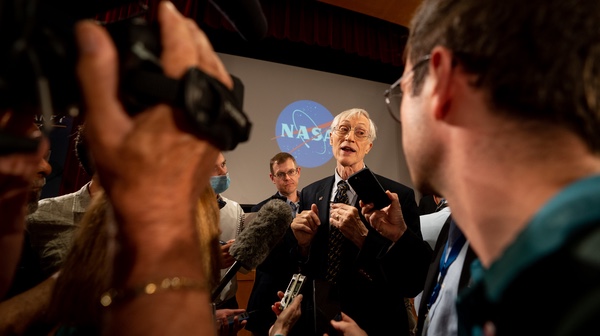 John Mather, who has been working on JWST since 1995, told reporters he was “so thrilled and so relieved” the telescope works. (credit: NASA/Taylor Mickal) |
Endings and beginnings
For some, the completion of JWST’s commissioning and the release of the first observations was the end of a decades-long effort. “As the commissioning winds down and we’re into science ops, we’re in a support role,” said Northrop Grumman’s Atkinson. “We’re there, ready to help whenever it's needed. Hopefully that call won’t come.”
| “How could you not discover stuff if you’re a hundred times more powerful than previous telescopes?” Rigby said. “Yeah, this is going to be revolutionary.” |
The company, he said, was gathering lessons learned from JWST it might apply to future programs. “We want to make sure we collectively pool the knowledge base of all the people who’ve been working on the program for a very long time to try to make sure we don’t lose any of those nuggets going forward.”
For astronomers, though, the mission is just getting started. While designed for a ten-year life, NASA confirmed last month that the accurate launch of the spacecraft by Europe’s Ariane 5 minimized the need for trajectory correction maneuver and left the spacecraft with enough stationkeeping propellant to operate for 20 years.
“It’s a cliché, but we’re turning the page on several new chapters on exoplanet atmospheres, the early universe,” Doyon said. “We don’t even know what we’re going to find.”
Rigby said that JWST promises to be two orders of magnitude—a factor of 100—more sensitive than other infrared telescopes. “How could you not discover stuff if you’re a hundred times more powerful than previous telescopes?” she said. “Yeah, this is going to be revolutionary.”
John Mather, the JWST project scientist at Goddard, has been involved with the mission since 1995, shortly after leading the COBE mission to study the cosmic microwave background that won him the Nobel Prize in physics. “I am so thrilled and so relieved,” he said at the Goddard event of the first JWST images.
“We are so thrilled that it works because there was so much at risk,” he said later. “The world has trusted us to put our billions into this and make it go, and it works. So it’s an immense relief.”
Jeff Foust (jeff@thespacereview.com) is the editor and publisher of The Space Review, and a senior staff writer with SpaceNews. He also operates the Spacetoday.net web site. Views and opinions expressed in this article are those of the author alone.
Note: we are using a new commenting system, which may require you to create a new account.
